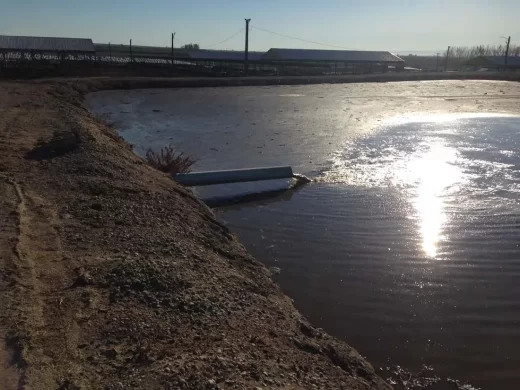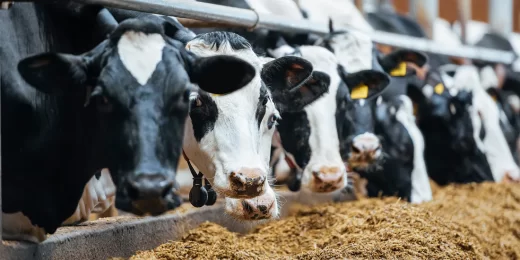
Six clean water wins in the first half of 2023
Factory farms dirty our waterways — and our movement is cleaning them up
By Masha Vernik, former Senior Communications and Organizing Coordinator at the Public Justice Food Project (now FarmSTAND)
Recently in Sackett v. EPA, the highest court in the nation weakened the Clean Water Act — only the latest setback in a series of attempts by Congress and the courts to chip away at the legal tools we have to protect our waterways. Despite these setbacks, our movement has scored six big wins in the fight to protect clean water from factory farm pollution in the first half of this year.
In a farming system that works with nature, animals contribute to the health of a thriving ecosystem, their manure providing valuable nutrients to the soil. But there’s a limit to how much manure the land can absorb and crops can use as fertilizer. Factory farms or Concentrated Animal Feeding Operations (CAFOs) hold more hogs, cows, or chickens than the land they’re on can sustain, resulting in untreated animal waste entering our waterways and aquifers in levels that are toxic to humans who drink the water as well as the plants and animals that live in it. Groundwater that communities depend on becomes unsafe to drink and can cause blue-baby syndrome and increase the risk of certain cancers. Bodies of water once teeming with marine plants and animals become devoid of life as toxic algae feeds on the manure nutrients and suck oxygen out of the water.
The impacts of these harms are not felt evenly. Communities who bear the burden of toxic pollution are often low-income and communities of color — many of whom deal with the overlapping harms of police brutality and economic disinvestment. The location of factory farms in these communities is no accident. It is an intentional choice by the agriculture industry based on a calculation that these communities have fewer resources to challenge or stop the construction of factory farms in their neighborhoods.
But community organizers alongside public interest attorneys continue to stand against factory farms to defend our health and protect our waterways. Thanks to the tireless efforts of people on the ground and legal experts, we’re moving closer to a world with healthy waterways and healthy communities.
Making Factory Farms Clean Up Their Act
1. Factory farm dairies in Yakima Valley, Washington will clean up the water they polluted
In June of this year, our movement scored a major victory when we made two factory farm dairies in Yakima Valley, WA, agree to clean up their act. In a legal settlement as a result of litigation brought by community groups, the mega-dairies DBD and SMD made major concessions for clean drinking water. The two dairies will not only limit future pollution and supply clean water to residents, but also fund research to test new methods of groundwater remediation that will do a better job of cleaning up the aquifer they dirtied.
In Washington’s Yakima Valley, there are dozens of factory farm dairies that have been getting bigger over time and contaminating the groundwater with nitrates and other agricultural pollutants. In 2017, 20% of wells tested by the U.S. Geological Survey had high levels of nitrate. According to Jean Mendoza, head of Friends of Toppenish Creek, “most people drink bottled water because they are worried about nitrates and pesticides in the drinking water.” The people who bear this burden are disproportionately immigrants: the valley is home to a large number of farmworkers, and around half of the county’s population are Hispanic or Latino, compared to 13% in all of Washington state. It is also the ancestral and current home of the Yakama Nation, who have long stewarded the land that CAFOs now occupy.
Over many years of opposition by tribal, conservation, and rural community groups, alongside public interest attorneys, one by one factory farm dairies in the Yakima Valley have been forced to clean up their act. This most recent win is especially exciting because the research funded by the dairies could provide a future gold standard for groundwater remediation following years of factory farm pollution. And the steps DBD and SMD will take to reduce their future pollution — double lining lagoons, installing groundwater monitoring wells, and limiting land applications of waste — are major changes to their operations that will significantly reduce pollution. This is a big win for communities and clean water!
The win came on the heels of an earlier victory in 2015, where the courts agreed with community groups that manure from a cluster of mega-dairies should be regulated as solid waste. This decision opened the door to using the Resource Conservation and Recovery Act (RCRA) to regulate factory farm waste, which was instrumental in the DMD and SMD case. In 2020, a factory farm called Sunnyside Dairy agreed to make significant changes to their operation to protect the groundwater from pollution.
Plaintiffs: Community Association for Restoration of the Environment, Friends of Toppenish Creek, and Center for Food Safety
Co-counsel: Law Offices of Charles M. Tebbutt, Public Justice, Terrell Marshall Law Group, Law Office of Andrea Rodgers
2. Poultry industry held accountable in Oklahoma
After nearly two decades of litigation, the poultry industry is finally being held accountable for polluting the Illinois River Watershed. In May 2023, a federal judge agreed that the poultry industry has been polluting and causing environmental damage to the watershed that Oklahomans’ depend on.
The stretch of the Illinois River in Oklahoma used to be so clear that you could see your feet when standing in the water waist-deep; now, it’s dense with agricultural pollution as industrial poultry facilities apply chicken litter (manure and bedding materials) onto fields and land, allegedly as fertilizer. That waste seeps into groundwater and streams and contaminates the watershed, effectively reducing the river that Oklahomans depend on for tourism to a sewer for industrial poultry facilities.
The State of Oklahoma filed the lawsuit back in 2005. But for nearly two decades, the court failed to issue a decision, which some speculate had to do with Oklahoma’s former Attorney General Scott Pruitt’s relationship with the poultry industry. Early this year, the court finally agreed that phosphorus pollution from the facility caused environmental harm and has “unreasonably interfered with the public’s right to the use and enjoyment of the waters of the Illinois River Watershed in Oklahoma.” The judge ordered the companies, including Tyson and Cargill, to contribute to remediation efforts and limit future pollution.
Plaintiffs: The State of Oklahoma, Oklahoma Attorney General, and Oklahoma Secretary of Energy and Environment
Co-counsel: Oklahoma Attorney General
Changing the Rules for Factory Farms
Lawsuits against individual factory farms benefit local people and ecosystems; but in order to address agricultural pollution nationwide, we need to change the rules — or the lack thereof — that govern how factory farms are allowed to operate. Much of the status quo is guided by agricultural exceptionalism, the legal and political system by which Big Ag does not have to follow the same labor, environmental, health, and safety rules as other industries. Our movement of grassroots groups and legal advocates together has been closing these loopholes one by one.
3. Increased government oversight of CAFOs
In April 2023, a district court struck down an environmental carveout for factory farms. Now, so-called “medium-sized” CAFOs will be subject to government oversight before receiving taxpayer dollars.
Our government has a duty to protect and invest in the health and wellbeing of people, our air, our water, and climate. But in 2016, USDA’s Farm Service Agency arbitrarily gave so-called medium-sized CAFOs a free pass to pollute, exempting at least 130 of them from the environmental impact review and community feedback process typically required of CAFOs before receiving government funds. Rural communities and communities of color living near those CAFOs pay the price with contaminated waterways and pervasive odors.
We joined forces with rural community, sustainable agriculture, and animal welfare groups in a lawsuit against USDA, claiming that the agency violated the National Environmental Policy Act and Administrative Procedure Act. Coinciding with a broader push to regulate water pollution from CAFOs, the U.S. District Court for the District of Columbia ruled in our favor and struck down the exemption.
Plaintiffs: Dakota Rural Action, White River Waterkeeper, Association of Irritated Residents, Citizens Action Coalition, Iowa Citizens for Community Improvement, Animal Legal Defense Fund, the Institute for Agriculture and Trade Policy, and Food & Water Watch.
Co-counsel: Public Justice, Animal Legal Defense Fund, and Food & Water Watch

Factory farms store some of their waste in massive cesspools called manure lagoons, from which pollution seeps into the groundwater below.
4. Better transparency in Colorado’s factory farm permit
As of May 2023, Colorado must better monitor water pollution from factory farms through its general permit for CAFOs, as a result of litigation brought by legal advocacy groups against Colorado’s Department of Public Health & Environment and the Colorado Livestock Association.
In order to keep our waterways healthy, we need better monitoring: Our government can’t limit pollution without knowing how much factory farms are polluting. However, Colorado’s general permit for factory farms had loopholes that hid critical information about how much pollution factory farms release into our waterways and when. According to the lawsuit, the general permit didn’t require monitoring that was adequately representative of the ongoing pollution of groundwater that leads into surface waters. The lawsuit argued that in doing so, Colorado was violating the Clean Water Act, which says that polluters need to show how they’re complying with pollution limitations. A state administrative law judge agreed, ruling that Colorado must modify the CAFO general permit to include representative monitoring of the pollution limits.
The Colorado win comes on the heels of other legal victories that required stricter monitoring of factory farms in Washington and Idaho.
Plaintiffs: Center for Biological Diversity and Food & Water Watch
Co-Counsel: Environmental Law Clinic at the University of Denver Sturm College of Law
5. EPA held accountable to creating stronger clean water rules
In April 2023, our movement held EPA accountable to answering our petition calling on the agency to strengthen clean water rules that govern factory farms. As a result of the same petition, in January of this year, EPA agreed to conduct a detailed study of factory farm pollution for the first time in fifteen years.
In order to track compliance with the Clean Water Act, the United States EPA issues pollution standards for factory farms, or mandatory effluent limitation guidelines (ELGs). EPA is supposed to review the ELGs every year, but the last time that the agency updated the guidelines based on new science and technology was in 2008. The ELGs set the regulatory “floor” that states must adhere to when issuing National Pollutant Discharge Elimination System (NPDES) permits. These permits are intended to control pollution and enable transparency — once a CAFO gets a NPDES permit, the government and the public have access to its pollution data and it can no longer hide its environmental damage. But right now, many factory farms don’t have a permit. And the permits that do exist are weak and inadequate. They contain loopholes, like the agricultural stormwater exemption that lets factory farms off the hook when rain washes their waste into rivers, lakes, and streams.
In our petition, we provide a roadmap for EPA to ensure that all factory farms get NPDES permits, and to make the permits stronger and more effective. Our groups filed the petition in 2017, but five years later in 2022, we still had not heard back. We sued the EPA to respond to our petition, claiming that the agency’s complete failure to respond violates the Administrative Procedure Act (APA), which requires agencies like EPA to respond to petitions “within a reasonable time.” EPA agreed to respond by August 15th.
As a result of our petition, in January of this year EPA agreed to conduct a study of factory farm pollution. The agency plans to collect more data on CAFO discharges and conduct a review of pollution-control technologies that have changed since 2008, when ELGs were last updated. While this study does not necessarily mean that EPA will strengthen its pollution standards — and is therefore a far cry from the commitment to protect waterways that we need — it is a step towards the better transparency necessary for stronger oversight.
Petitioners: Food & Water Watch, Center for Food Safety, Dakota Rural Action, Dodge County Concerned Citizens, the Environmental Integrity Project, Helping Others Maintain Environmental Standards, Institute for Agriculture and Trade Policy, Iowa Citizens for Community Improvement, Kewaunee CARES, Midwest Environmental Advocates, and North Carolina Environmental Justice Network
Co-counsel: Food & Water Watch, Earthrise Law Center, and Public Justice

Factory farms hold more animals than the land they’re on can sustain.
6. EPA to create national standards for slaughterhouse pollution
In March 2023, EPA announced that it would update national standards for slaughterhouse pollution as a result of litigation brought against the agency for failing to hold slaughterhouses accountable for polluting our waterways.
Slaughterhouses and rendering facilities, like factory farms themselves, are major sources of water pollution. They use a lot of water to process animal parts and then discharge dirty water filled with blood and fat into our waterways. For example, we sued two JBS-Swift slaughterhouses in Colorado for discharging animal fat, blood, meat, dangerous bacteria, ammonia, and excrement into a tributary of Colorado’s South Platte River. Slaughterhouses are often concentrated in low-income communities and communities of color. An analysis of 184 slaughterhouse and rendering facilities that discharge pollution directly into rivers and streams found that they were more likely to be located within a mile of what EPA defines as low-income or linguistically isolated communities.
Despite all this, EPA’s national standards for slaughterhouse pollution are either weak or non-existent — violating its duty to protect communities from industrial pollution. Only 300 of over 7,000 meat processing facilities are covered by existing water pollution standards. And in 2019, the agency decided not to update federal standards for slaughterhouses that discharge wastewater directly into waterways. Because of the efforts of community organizers and legal advocates to hold the agency accountable to protecting our waterways and communities, EPA committed to creating a new standard for slaughterhouses for the first time in nearly 20 years.
“EPA has the authority and responsibility to stop slaughterhouses from polluting our water,” said Devon Hall, co-founder of the Rural Empowerment Association for Community Help based in eastern North Carolina and one of the plaintiffs in the lawsuit. “If EPA doesn’t do its job, who will?”
Plaintiffs: Cape Fear River Watch, Rural Empowerment Association for Community Help, Waterkeepers Chesapeake, Animal Legal Defense Fund, Center for Biological Diversity, Comite Civico del Valle, Environment America, Food & Water Watch, The Humane Society of the United States, and Waterkeeper Alliance.
Co-counsel: Earthjustice, Environmental Integrity Project
Even if our government isn’t living up to its responsibility, our movement is continuing the fight to protect communities and waterways from factory farm waste — and holding our government accountable to doing the same. We filed a lawsuit to defend the Snake River in Idaho from factory farm pollution of Simplot’s Grand View Feedlot. And in North Carolina, residents filed a civil rights complaint with the EPA, claiming that the state’s failure to regulate industrial poultry pollution discriminates against Native, Black, and Latino communities. A coalition of Oregon environmental groups petitioned EPA to take emergency action on the high nitrate levels in their water, and in response EPA is now urging Oregon to clean up the contamination or else EPA will step in.
We’re going to continue our work until we see a world with healthy waterways, where everyone can drink clean water and no community lives in a sacrifice zone.
